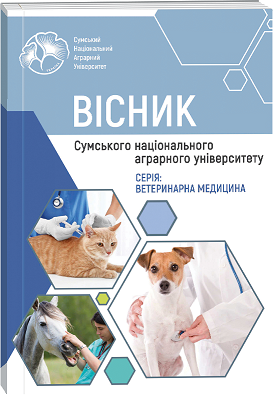Поширення арахноентомозів коней
Анотація
У статті наведено результати дослідження поширення та сезонної динаміки арахноентомозів коней. Виявлено, що найбільш поширеними арахноентомозами коней є гематопіноз, гіпобоскоз, хоріоптоз та саркоптоз. Встановлено, що пік гематопінозної інвазії припадає на осінньо-зимовий період 28% та 19%, тоді як у весняно-літній період цей показник складав 7% та 2%, відповідно. Конячу кровососку Нурроbosca equine виявляли тільки в літній період року. Виявлено одночасне паразитування у коней вошей Haematopinus asini та кліщів - хоріоптесів. Акарози хоріоптоз та саркоптоз досягали піку інвазії в осінньо-зимовий період року 20% та 22% і відповідно 8% та 7%.
Посилання
2. Antypov, A.A., Ponomar, S.Y., Honcharenko V.Y. (2011). Efektyvnist Ekvisekt pasty pry nematodozakh konei [Efficacy of Equisect paste in horse nematodes]. Veterinarna meditsina [Veterinary medicine], 95, 317-318. (in Ukrainian).
3. Bayarjargal Y., Karnieli A., Bayasgalan M., Khudulmur S., Gandush C., Tucker C.J. (2006). A comparative study of NOAA-AVHRR derived drought indices using change vector analysis. Remote Sensing of Environment 105(1): 9-22. DOI: https://doi.org/10.1016/j.rse.2006.06.003
4. Berezovskij, A.V. (2000). Likarski preparati novogo pokolinnya dlya veterinarnoyi medicine [Medicines of new generation for veterinary medicine] Vetinform, 88. (in Ukrainian).
5. Fedorov N.I., Mikhailenko O.I., Zharkikh T.L., Bakirova R.T. (2018). Mapping of Vegetation with the Geoinformation System and Determining of Carrying Capacity of the Pre-Urals Steppe area for a Newly Establishing Population of the Przewalski Horse Equus ferus przewalskii at the Orenburg State Nature Reserve. IOP Conference Series: Earth and Environmental Science 107(1): 012100. DOI: https://doi.org/10.1088/1755-1315/107/1/012100
6. Galatyuk, O.Ye. (2003). Kontrol endoparazitoziv konej. [Control of horses` endoparasitoses] Visnik Poltavskoyi derzh. Agrarn. Akademiya.[Poltava state aacademy bulletin]. 1(2). 64-69. (in Ukrainian).
7. Halat, V.F & Chornyi, V.A. (2007). Diahnostyka, profilaktyka ta zakhody borotby z psoroptozom ovets. Metodychni rekomendatsii, 15. (in Ukrainian).
8. Hansford, K.M., Gillingham, E.L., Cull, B., McGinley, L., Medlock, J.M., Phipps, L.P., Peaty, M. (2019). Disease and ticks on horses. Vet Rec. 11; 184(19):592. Doi: https://doi.org/10.1136/vr.l2056.
9. Horak, IG., Heyne, H., Halajian, A., Booysen, S., Smit WJ.(2017). Parasites of domestic and wild animals in South Africa. L. Ixodid ticks infesting horses and donkeys. Onderstepoort J Vet Res. Feb 28;84(1):e1-e6. doi: https://doi.org/10.4102/ojvr.v84i1.1302.
10. Jacqueline, B. Matthews. (2014). Anthelmintic resistance in equine nematodes. International Journal for Parasitology: Drugs and Drug Resistance, 4,3, 310-315. https://doi.org/10.1016/j.ijpddr.2014.10.003
11. Klei T.R. (2000). Equine immunity to parasites. [Vet Clin North Am Equine], 16(1):69-78, vi. doi: https://doi.org/10.1016/s0749-0739(17)30119-0.
12. Mhadhbi, M., Sassi, A. (2020). Infection of the equine population by Leishmania parasites. Equine Vet., 52(1):28-33. doi: https://doi.org/10.1111/evj.13178.
13. Peregrine, A.S., Molento, M.B., Kaplan, R.M., Nielsen, M.K. (2014). Anthelmintic resistance in important parasites of horses: does it really matter? Vet Parasitol, 201(1-2):1-8. Doi: https://doi.org/10.1016/j.vetpar.2014.01.004.
14. Scott, I., Bishop, R.M., Pomroy, WE. (2015). Anthelmintic resistance in equine helminth parasites - a growing issue for horse owners and veterinarians in New Zealand. N Z Vet J, 63(4):188-98. DOI: https://doi.org/10.1080/00480169.2014.987840 .
15. Sokół, R., Raś-Noryńska, M., Michalczyk, M., Raś A., Rapacz-Leonard A., Koziatek S. (2015). Estimation of infection of internal parasites in horses from different type of farms. Ann Parasitol.;61(3):189-92. DOI: https://doi.org/10.17420/ap6103.06.
16. Stancampiano, L., Mughini, Gras. L., Poglayen, G. (2010). Spatial niche competition among helminth parasites in horse's large intestine. Vet Parasitol, 28;170(1-2):88-95. DOI: https://doi.org/10.1016/j.vetpar.2010.01.031.
17. Thompson, K.R., Clarkson, L., Riley, C.B., van den Berg, M. (2018). Horse Husbandry and Preventive Health Practices in Australia: An Online Survey of Horse Guardians. J Appl Anim Welf Sci., 21(4):347-361. DOI: https://doi.org/10.1080/10888705.2018.1428099.
18. Wilkes, EJA., Heller, J., Raidal, SL., Woodgate, RG., Hughes, KJ. (2020). A questionnaire study of parasite control in Thoroughbred and Standardbred horses in Australia. Equine Vet J. Jul;52(4):547-555. DOI: https://doi.org/10.1111/evj.13207.

Ця робота ліцензується відповідно до Creative Commons Attribution 4.0 International License.

 ISSN
ISSN  ISSN
ISSN 



